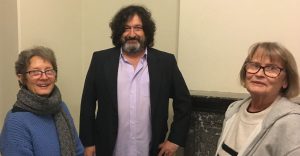Andrew Wood, Blue Wren Subcommittee Convenor, Bulletin 4/2022, June 2022
Annual biodiversity lecture
At Benledi on 25 May, Professor Dieter Hochuli from Sydney University’s School of Life and Environmental Sciences gave the 7th Annual Biodiversity Talk to an enthusiastic room of local nature lovers. The topic was: How nature survives and thrives in urban environments, and why it matters for the future of our cities.
The work of Dieter and his colleagues on the ecology of cities has involved extensive research on all manner of birds, bats, bugs, ants, mammals – and their interaction with humans. His talk was particularly relevant to Glebe as he lives and works locally, and his presentation aimed to offer something for the diversity of ‘optimists, pessimists and realists’ amongst us.
It seems that we are all likely to become much more familiar (more ‘moundful’!) with the presence and amazing lifestyle of the brush turkey. This bolshie bird seems to be tracking further into ‘areas of affluence’ and places with green spaces, where it likes to build its characteristic mounds. We learned that the ‘work ethic’ of the brush turkey is second to none. Some brush turkeys are sedentary homebodies, while others prefer adventure travel. One tagged brush turkey, released at Sydney University, travelled along train lines to make a new home at Oatley!
We also learned that local attributes are the driver for diversity and of the need to encourage and promote important native pollinators such as native bees and hoverflies, including through planting appropriate flower species. Research has shown that exotic species are vital floral resources for urban pollinators, so it is important ‘to get the juggle right’ between native and exotic species. (We also need to be careful about removing ‘weedy species’ – bush regenerators are aware of this – as even lantana can provide great habitat for small insectivorous birds, such as blue wrens.)
We should also watch out for our local hoverflies in winter, as they are such important pollinators, eating our aphids and pollinating flowers – six or seven different species have been noted in research at Paddy Gray Reserve in Hereford St, Glebe.
Dieter also reported that some local vets have seen recent cases of paralysis ticks affecting cats, a new issue for us on this side of the harbour. Researchers are working to establish whether bandicoots or rats are the primary hosts for paralysis ticks.

Other research has focused on the wellbeing benefits of engaging with nature. In an urban setting, how accessible and close it is (‘nature near you’) seems to be more important than how good it actually is. Research on the benefits of urban trees has shown both heat and biodiversity benefits. And, while we know that being in nature is good for us, research shows that urban children’s connection to nature varies significantly according to their age and gender. This suggests we need to find new ways to engage children. A forthcoming book by Dieter and colleagues, Creatures in Your Neighbourhood, will try to encourage everyone to look at what’s happening ‘under their own noses’ – in their local environments.
The limited benefits of installing Green Roofs and Green Walls were noted. While they may wow us with their beauty and benefit our general wellbeing, the limited palette of plants that can thrive there doesn’t actually provide much biodiversity or habitat for our cities.
Similarly, the installation of ‘bee hotels’, a good idea at the time, can sometimes disappoint – when the parasitic wasps move in. It is in our interest to do better.
The conclusion reached was that the human dimension in urban ecology is central to reconciling the positive and negative perspectives on nature in our cities. On an optimistic note, efforts to bring small birds back to Glebe through a future ‘translocation’ research project could be successful, under the right conditions.
The Blue Wren Subcommittee thanks Mary Holt and Norma Hawkins (the Society’s oldest member, turning 100 later this year) for their generous financial support for the annual lectures. Aviva Lacey from Natural Selection Souvenirs again brought a selection of blue wren and other items for sale and donated a portion of the sale proceeds to the Subcommittee.
News from Glebe’s bushcare groups
The Orphan School Creek Bushcare Group held a planting day on Saturday 23 April 2022, and native flora were added to a previously mulched site that lacked a good topsoil layer. Members had previously attended the City’s onsite ‘Induction to Environmental Management Plan’ to ensure that the work could be safely performed. On Tuesday 3 May, workers from the National Trust bushcare contractors removed and sprayed weeds in the park to prepare a new area for future planting by volunteers. Further planned events are a working bee on Sunday 29 May and a planting day on Saturday 25 June.
In Paddy Gray Reserve, the lower half of the Reserve is waterlogged following the recent rain. An unsafe eucalypt was removed from the Hereford St entrance to the Reserve, and the recently-planted eucalypts are not thriving. The City’s maintenance of the Reserve is poor and, unless it improves, the Society will need to send a letter to the City’s CEO asking that the City’s maintenance contractors prioritise the Reserve.
The Glebe Palmerston and Surrounds Landcare Group has not yet received a reply to their letter to Jenny Kent, the City’s Community Gardens and Volunteer Coordinator, asking that numerous maintenance items be addressed.
Nick Sangster will initiate the formation of a local volunteer bushcare/landcare group to commence work in Harold Park. The first task could be the weeding and planting of the swales.








There are no comments yet. Please leave yours.